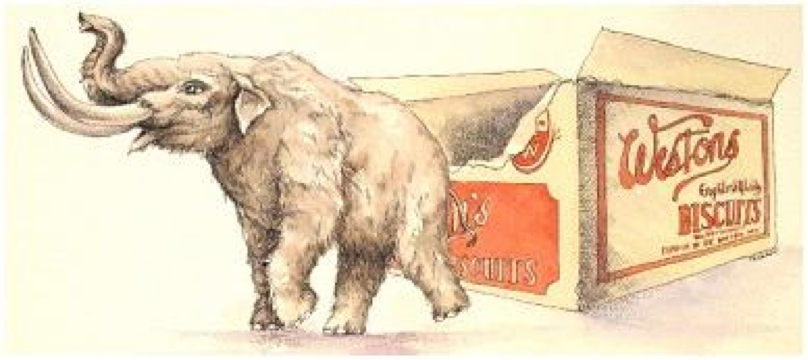65.5 Million Years Ago - 10,000 Years Ago
The Cenozoic Era Animals (Quick Links)
Highlights of the Cenozoic
- Since the Azolla event 49 million years ago, the Cenozoic Era has been a period of long-term cooling
- Mammals diverged from a few small, simple, generalized forms
- Major time of evolution of snakes, birds and insects
The Earth has been through numerous cooling and subsequent warming periods since its formation. The last major cooling period occurred from 70,000 years to 10,000 years ago, in which extensive ice sheets covered large parts of North America and Eurasian continents. At least 7 ice ages have been recognized.
It may be hard to imagine, but about 20,000 years ago Canada was at the peak of its last glaciations and 97% of Canada was entirely covered by ice! The animals which lived on the planet at this time had to adjust so many of them had thick coats of fur. Please scroll down the page and learn more about the ice age mammal.
Mastodon
-
Genus: Mammut

- Size: Similar to an elephant (about 6.5-10 feet tall)
- Location: Asia, Africa, Europe, North America and Central America
- Diet: Mastodons were plant eaters who ate the leaves of trees, shrubs, mosses, twigs, and other plants. Some mastodons have been found with food in their stomach!
- When I lived: Oligocene – Pleistocene (33.9 million years ago -11,000 years ago)
- What special Feature did I have? I had large upper tusks (mammoths had lower tusks) which I may have used for pushing snow aside to get the vegetation underneath. I also had long, brown, shaggy fur to keep me warm!
- The mastodon is named for its teeth. The name is translated as “nipple tooth”. Mastodons ate spruce trees and similar vegetation. The unworn teeth have points of enamel. The worn one have a smooth polished surface of dentine. Worn teeth were replaced by new ones growing in from the back of the jaw, pushing out the worn ones at the front.
Mammoth
- Genus: Mammuthus
- Size: 11.5 feet long, 9.5 feet tall
- Weight: 3 tonnes
- Location: Asia, Africa, Europe, North America and Central America
- Diet: grasses
- When I lived: Pliocene to Pleistocene (4.8 million years ago to 4,500 years ago)
- What special Feature did I have? I had long, black, shaggy fur and two huge, curving lower tusks (A mastodon had upper tusks), I used my tusks for protection and digging in the snow for food
There were many different types of mammoths living in both the old and new world as recently as 10,000 years ago. The Woolly, Northern or Siberian mammoth is by far the best known of all the mammoths. We know quite a lot about the Woolly mammoth from skeletal remains, cave paintings, and by examination of carcasses of these elephants recovered from the permafrost in Siberia.
The woolly mammoth was about 3 metres tall at the shoulder and was well adapted to cold climate. They were covered in a woolly, yellowish-brown undercoat about 3 cm thick beneath a coarser outer covering of dark brown hair up to 50 cm long. Paleolithic artists also illustrated the mammoth covered with long shaggy hair. Mammoth tusks a metre or more in length have been found in many localities. Tusk fragments were found in the west Lorne area in June 1982.
View our Mammoth and Mastodon Collection!
In the summer of 2009, Brittany Groves, an NSERC co-op student, undertook a research project for the Earth Sciences Museum, to investigate and record the mastodons and mammoths found in southern Ontario. The project involved contacting 190 museums in Ontario, researching historical documents and tracking down known specimens and their current location. The information gathered from the project will be used to create a database of mastodon and mammoth finds to be used for further research and also to create material for public education.
This project stems from the circumstances that started with Shirley Fenton finding a box of unusual objects in her family’s attic, in 2006. Shirley brought these objects to Peter Russell, curator of the Earth Sciences Museum, at the University of Waterloo, who identified them as three mastodon teeth and a lower tusk. When Peter found out the Fenton family home was in Highgate, he suggested a Google search for Highgate mastodon, to see if any other finds would pop up. To their surprise, the most complete mastodon skeleton ever found in Southern Ontario was found in Highgate, and was on display at the North Dakota Heritage Centre in Bismarck, North Dakota. This presented Peter with many more questions on the subject. To read the rest of the Highgate Mastodon story, search for Highgate Mastodon in Google.
To date, 98 mastodon, 32 mammoth and 30 indeterminate proboscidea sites have been recorded in Southern Ontario. The largest concentrations of these are mastodon sites along the north shore of Lake Erie.
View a Map that shows the approximate locations of these finds and what exactly was found at them.
Stegodon “Roofed Tooth”
- Genus: Stegodon
- Size: 8 metres (26 feet) in length and 4 metres (13 feet) in height
- Diet: I ate a variety of vegetation such as bamboo and leaves
- When I lived: Pliocene epoch to the end of the Pleistocene (11.6 million years ago- 11,000 years ago)
- What special Feature did I have? I must have been a good swimmer because my fossils are frequently encountered on Asian islands, which even during periods of low sea-level were not connected by land bridges with the Asian continent.
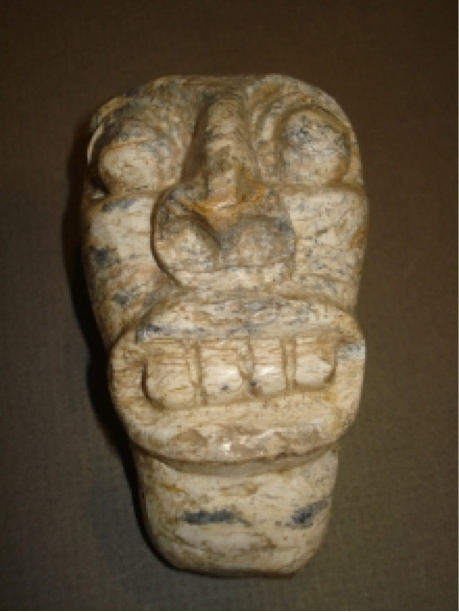
Carved stegodon tusk. Java, Indonesia. Stegodons lived there until 11,000 years ago
Sabre Tooth Cat “Knife Tooth”
-
Genus: Smilodon
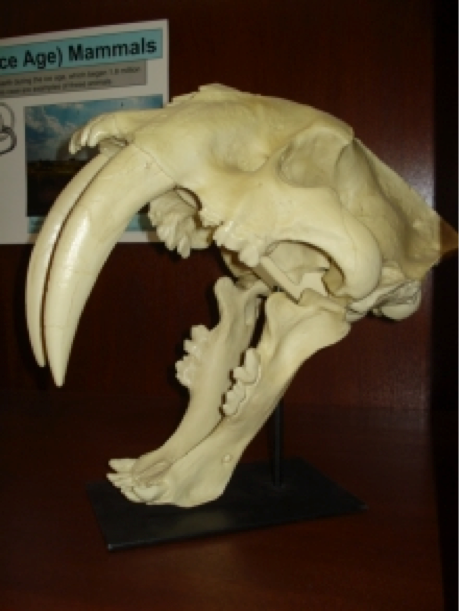
- Size: 4-5 feet in length and 8 feet in height
- Weight: 200 kg
- Diet: hunted animals such as sloths, mammoths, and other large prey
- When I lived: Eocene epoch to the end of the Pleistocene (42 million years ago- 11,000 years ago)
- What special Feature did I have? My canine teeth extended from my mouth even when it was closed. Despite popular belief, not all animals known as sabre-toothed cats were closely related to modern felines. Evidence suggests what we were social carnivores and hunted in packs like lions
Irish Elk
Genus: Megaloceros
-
Size: we stood around 7 feet tall at the shoulder

- Weight: about 450 kg
- Location: Europe
- Diet: Our favourite food source was from vast grasslands and small lakes. We enjoyed grazing on the leaves of small plants and grasses
- When I lived: From late Pliocene to Late Pleistocene
- What special Feature did I have? Despite our misleading name, we were actually deer. Our antlers were around 12 feet wide, the size of a small car. Our antlers were so big that just staying upright was a challenge for us!
Cave Bear
-
Genus: Ursus spelaeus
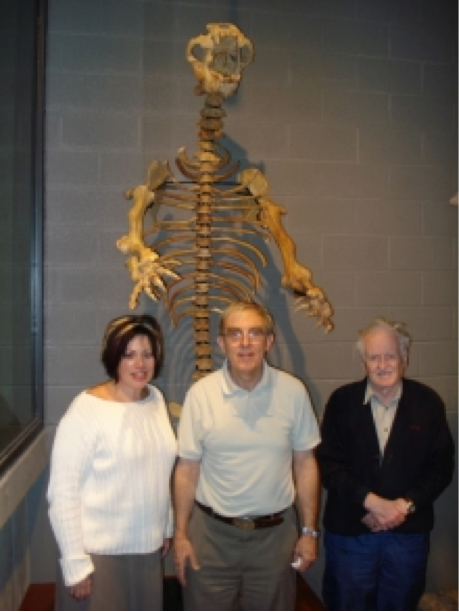
- Size: Cave bears were comparable in size to the largest modern day bears
- Weight: Males weighed approximately 400-500 kg, which the females weighed 225-250 kg
- Location: Europe
- Diet: Our diet likely consisted of tough materials. Their diets were largely vegetarian
- When I lived: Pleistocene till about 27,500 years ago
- What special Feature did I have? We spent a large amount of our time in caves. In fact, most of our skeletons have been found in caves. There is one cave in Romania which is called Bears’ Cave where 140 cave bear skeletons were discovered in 1983.
- Donated to the museum by J. Frank Brookfield
Giant Beaver
-
Genus: Castoroides
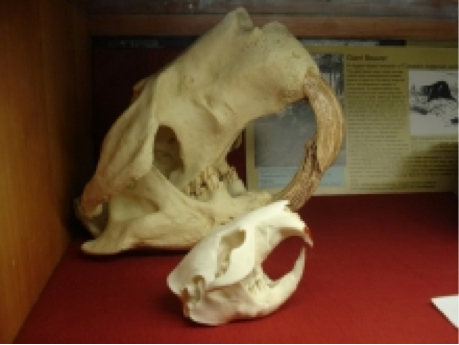
- Size: 8 feet long
- Weight: 60 to 100kg (the size of a black bear)
- Location: North America
- Diet: Plants
- When I lived: the oldest fossils are about 1.4 million years old. It is estimated that the giant beaver died out in North America about 10,000 years ago
- What special Feature did I have? The cutting teeth of the Giant Beaver were up to 6 inches long. They had prominently ridged outer surfaces and blunt, rounded tips, unlike the chisel-like teeth of today’s modern beaver. Their teeth were well adapted to grinding up the plants that made up the animals diet.
For further information on the sites, please contact the Earth Sciences Museum at earthmuseum@uwaterloo.ca.
